
|
Classes | |
| struct | cldnn_activation_desc |
| Activation using rectified linear unit or parameterized rectified linear unit. More... | |
| struct | cldnn_batch_norm_desc |
| Batch normalization primitive. More... | |
| struct | cldnn_concatenation_desc |
| struct | cldnn_convolution_desc |
| Performs forward spatial convolution with weight sharing. Also supports built-in Relu cldnn_activation_desc available by setting it in arguments. More... | |
| struct | cldnn_crop_desc |
| Performs crop operation on input. More... | |
| struct | cldnn_custom_gpu_primitive_desc |
| This primitive executes a custom kernel provided by the application. More... | |
| struct | cldnn_data_desc |
| Provides input data to topology. More... | |
| struct | cldnn_deconvolution_desc |
| Performs transposed convolution. Also supports built-in Relu cldnn_activation_desc available by setting it in arguments. More... | |
| struct | cldnn_detection_output_desc |
| Generates a list of detections based on location and confidence predictions by doing non maximum suppression. More... | |
| struct | cldnn_eltwise_desc |
| Performs elementwise operations (sum, subtract, max or product) on two input primitives Also supports built-in Relu cldnn_activation_desc available by setting it in arguments. . More... | |
| struct | cldnn_fully_connected_desc |
| Performs forward fully connected layer (inner product). Also supports built-in Relu cldnn_activation_desc available by setting it in arguments. More... | |
| struct | cldnn_input_layout_desc |
| Provides input layout for a data to be passed later to network. More... | |
| struct | cldnn_lrn_desc |
| Local response normalization. More... | |
| struct | cldnn_normalize_desc |
| Normalizes the input using an L2 norm and multiplies the output with scale value. The scale can be equal for all channels or one scale per channel. More... | |
| struct | cldnn_permute_desc |
| Permutes data in the memory, with respect to provided order. More... | |
| struct | cldnn_pooling_desc |
| Performs "pooling" operation which is a form of non-linear down-sampling. More... | |
| struct | cldnn_prior_box_desc |
| Generates a set of default bounding boxes with different sizes and aspect ratios. More... | |
| struct | cldnn_proposal_desc |
| struct | cldnn_region_yolo_desc |
| region softmax specific for yolo2 topology More... | |
| struct | cldnn_reorder_desc |
| Changes how data is ordered in memory. Value type is not changed & all information is preserved. More... | |
| struct | cldnn_reorg_yolo_desc |
| yolo2 topology specific data reorganization primitive More... | |
| struct | cldnn_reshape_desc |
| Changes information about inputs's layout effectively creating new memory which share underlaying buffer but is interpreted in a different way (different shape). More... | |
| struct | cldnn_roi_pooling_desc |
| struct | cldnn_scale_desc |
| Performs elementwise product of input and scale_input. More... | |
| struct | cldnn_softmax_desc |
Normalizes results so they sum to 1. The scope of normalization is defined by a member dimension. More... | |
| struct | cldnn_split_desc |
| Performs split operation on input. More... | |
| struct | cldnn_upsampling_desc |
| Performs nearest neighbor/bilinear upsampling Also supports built-in Relu activation available by setting it in arguments. More... | |
Macros | |
| #define | CLDNN_ROI_VECTOR_SIZE 5 |
Enumerations | |
| enum | cldnn_concatenation_axis { cldnn_concatenation_along_b = 0, cldnn_concatenation_along_f = CLDNN_TENSOR_BATCH_DIM_MAX, cldnn_concatenation_along_x = CLDNN_TENSOR_BATCH_DIM_MAX + CLDNN_TENSOR_FEATURE_DIM_MAX, cldnn_concatenation_along_y = cldnn_concatenation_along_x + 1 } |
| enum | cldnn_prior_box_code_type { cldnn_code_type_corner, cldnn_code_type_center_size, cldnn_code_type_corner_size } |
| Select method for coding the prior-boxes in Detection Output layer ( cldnn_detection_output_desc ). | |
| enum | cldnn_eltwise_mode { cldnn_eltwise_sum, cldnn_eltwise_sub, cldnn_eltwise_max, cldnn_eltwise_prod } |
| Select mode for eltwise layer ( cldnn_eltwise_desc ). More... | |
| enum | cldnn_lrn_norm_region { cldnn_lrn_norm_region_across_channel, cldnn_lrn_norm_region_within_channel } |
| enum | cldnn_pooling_mode { cldnn_pooling_max, cldnn_pooling_average, cldnn_pooling_average_no_padding } |
| Select method for Pooling layer ( cldnn_pooling_desc ). More... | |
| enum | cldnn_softmax_dimension { cldnn_softmax_normalize_f, cldnn_softmax_normalize_x, cldnn_softmax_normalize_y, cldnn_softmax_normalize_fyx } |
| Enum type to specify softmax's normalization scope (see cldnn_softmax_desc::dimension). | |
| enum | cldnn_upsampling_sample_type { cldnn_upsampling_nearest, cldnn_upsampling_bilinear } |
| Sample mode for upsampling layer ( cldnn_upsampling_desc ). More... | |
Functions | |
| cldnn_primitive_type_id | cldnn_activation_type_id (cldnn_status *status) |
| cldnn_primitive_type_id | cldnn_batch_norm_type_id (cldnn_status *status) |
| cldnn_primitive_type_id | cldnn_concatenation_type_id (cldnn_status *status) |
| cldnn_primitive_type_id | cldnn_convolution_type_id (cldnn_status *status) |
| cldnn_primitive_type_id | cldnn_crop_type_id (cldnn_status *status) |
| cldnn_primitive_type_id | cldnn_custom_gpu_primitive_type_id (cldnn_status *status) |
| cldnn_primitive_type_id | cldnn_data_type_id (cldnn_status *status) |
| cldnn_primitive_type_id | cldnn_deconvolution_type_id (cldnn_status *status) |
| cldnn_primitive_type_id | cldnn_detection_output_type_id (cldnn_status *status) |
| cldnn_primitive_type_id | cldnn_eltwise_type_id (cldnn_status *status) |
| cldnn_primitive_type_id | cldnn_fully_connected_type_id (cldnn_status *status) |
| cldnn_primitive_type_id | cldnn_input_layout_type_id (cldnn_status *status) |
| cldnn_primitive_type_id | cldnn_lrn_type_id (cldnn_status *status) |
| cldnn_primitive_type_id | cldnn_normalize_type_id (cldnn_status *status) |
| cldnn_primitive_type_id | cldnn_permute_type_id (cldnn_status *status) |
| cldnn_primitive_type_id | cldnn_pooling_type_id (cldnn_status *status) |
| cldnn_primitive_type_id | cldnn_prior_box_type_id (cldnn_status *status) |
| cldnn_primitive_type_id | cldnn_proposal_type_id (cldnn_status *status) |
| cldnn_primitive_type_id | cldnn_region_yolo_type_id (cldnn_status *status) |
| cldnn_primitive_type_id | cldnn_reorder_type_id (cldnn_status *status) |
| cldnn_primitive_type_id | cldnn_reorg_yolo_type_id (cldnn_status *status) |
| cldnn_primitive_type_id | cldnn_reshape_type_id (cldnn_status *status) |
| cldnn_primitive_type_id | cldnn_roi_pooling_type_id (cldnn_status *status) |
| cldnn_primitive_type_id | cldnn_scale_type_id (cldnn_status *status) |
| cldnn_primitive_type_id | cldnn_softmax_type_id (cldnn_status *status) |
| cldnn_primitive_type_id | cldnn_split_type_id (cldnn_status *status) |
| cldnn_primitive_type_id | cldnn_upsampling_type_id (cldnn_status *status) |
Detailed Description
Class Documentation
◆ cldnn_activation_desc
| struct cldnn_activation_desc |
Activation using rectified linear unit or parameterized rectified linear unit.
Can get one negative slope or negative slope per channel.
- Algorithm:
- out(i,x,y) = max(0, in(i,x,y)) + slope(i) * min(0, in(i,x,y))
- Where:
- out(i,x,y) : value at x, y from i-th feature map after activation.
- in(i,x,y) : value at x, y from i-th feature map before activation.
- slope(i) : the slope value of the i-th feature map (can be shared across channels or one slope per channel).
Definition at line 41 of file activation.h.
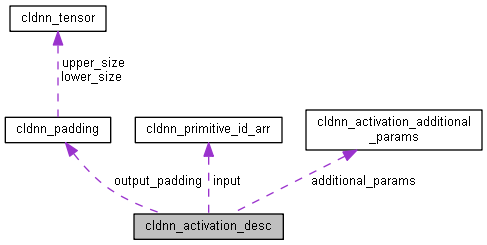
| Class Members | ||
|---|---|---|
| cldnn_activation_func | activation_func | activation function. |
| cldnn_activation_additional_params | additional_params | Activation additional params. activation_relu_negative_slope - additional_params.a is a negative slope activation_brelu - additional_params.a is a upper bound activation_linear - additional_params.a/b uses as a*val + b. |
| cldnn_primitive_id | additional_params_input | Activation additional params stored on a memory object activation_relu_negative_slope - negative slope per feature map activation_brelu - upper bound per feature map activation_linear - a,b per feature map. |
| cldnn_primitive_id | id | Primitive id unique within a topology. |
| cldnn_primitive_id_arr | input | Input primitives ids. |
| cldnn_padding | output_padding | Output padding information. |
| cldnn_primitive_type_id | type | Primitive type identificator. |
◆ cldnn_batch_norm_desc
| struct cldnn_batch_norm_desc |
Batch normalization primitive.
Performs batch normalization as described in "Batch Normalization: Accelerating Deep Network Training by Reducing Internal Covariate Shift" by Ioffe, Szegedy
See: http://arxiv.org/abs/1502.03167
Algorithm:
global stats can be computed as:
out[i] = in[i] - mean[b] / sqrt(variance[b] + epsilon)
Definition at line 42 of file batch_norm.h.

| Class Members | ||
|---|---|---|
| float | epsilon | Epsilon. |
| cldnn_primitive_id | id | Primitive id unique within a topology. |
| cldnn_primitive_id_arr | input | Input primitives ids. |
| cldnn_primitive_id | mean | Primitive id containing mean data. |
| cldnn_padding | output_padding | Output padding information. |
| cldnn_primitive_type_id | type | Primitive type identificator. |
| cldnn_primitive_id | variance | Primitive id containing variance. |
◆ cldnn_concatenation_desc
| struct cldnn_concatenation_desc |
Concatenation is used to concatenate multiple sources into one destination along specified dimension. Note that all other dimensions (except the one along which concatenation take place) must have the same value in each source and each source should have the same format.
- Alogrithm:
- Where:
- input : data structure holding all source inputs for this primitive
- output : data structure holding output data for this primitive
- i.features : number of features in currently processed input
- outputIdx : index of destination feature
Definition at line 61 of file concatenation.h.
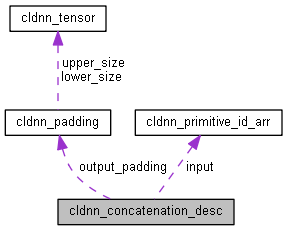
| Class Members | ||
|---|---|---|
| cldnn_concatenation_axis | axis | Dimension along which concatenation should take place. |
| cldnn_primitive_id | id | Primitive id unique within a topology. |
| cldnn_primitive_id_arr | input | Input primitives ids. |
| cldnn_padding | output_padding | Output padding information. |
| cldnn_primitive_type_id | type | Primitive type identificator. |
◆ cldnn_convolution_desc
| struct cldnn_convolution_desc |
Performs forward spatial convolution with weight sharing. Also supports built-in Relu cldnn_activation_desc available by setting it in arguments.
Parameters are defined in context of "direct" convolution, but actual algorithm is not implied.
Definition at line 36 of file convolution.h.
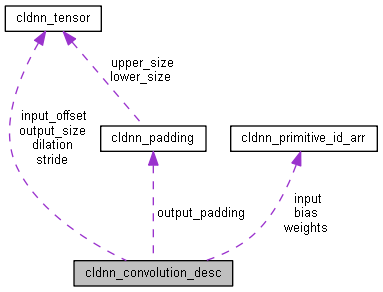
| Class Members | ||
|---|---|---|
| float | activation_negative_slope | Relu activation slope. |
| cldnn_primitive_id_arr | bias |
Array of primitive ids containing bias data. Size of array should be equivalent to split. |
| cldnn_tensor | dilation | Defines gaps in the input - dilation rate k=1 is normal convolution, k=2 means skipping one pixel per input, k=4 means skipping 3 pixels. As an example in one dimension, a filter w of size 3 would compute over input x the following: w[0]*x[0] + w[1]*x[1] + w[2]*x[2] for dilation of 1. For dilation 2 the filter would instead compute w[0]*x[0] + w[1]*x[2] + w[2]*x[4]. |
| cldnn_primitive_id | id | Primitive id unique within a topology. |
| cldnn_primitive_id_arr | input | Input primitives ids. |
| cldnn_tensor | input_offset | Defines a shift, relative to (0,0) position of the input buffer, where (0,0) point of the convolution window should start calculations. |
| cldnn_padding | output_padding | Output padding information. |
| cldnn_tensor | output_size | User-defined output data size of the primitive (w/o padding). |
| uint32_t | split | On how many cards split the computation to. |
| cldnn_tensor | stride | Defines shift in input buffer between adjacent calculations of output values. |
| cldnn_primitive_type_id | type | Primitive type identificator. |
| cldnn_primitive_id_arr | weights |
Array of primitive ids containing weights data. Size of array should be equivalent to split. |
| uint32_t | with_activation | Enable Relu activation. |
| uint32_t | with_output_size | Indicates that the primitive has user-defined output size (non-zero value). |
◆ cldnn_crop_desc
| struct cldnn_crop_desc |
Performs crop operation on input.
Crops the input to the shape of reference_input accross all dimensions taking into account specified input offsets.
Examples
Crop without offset example:
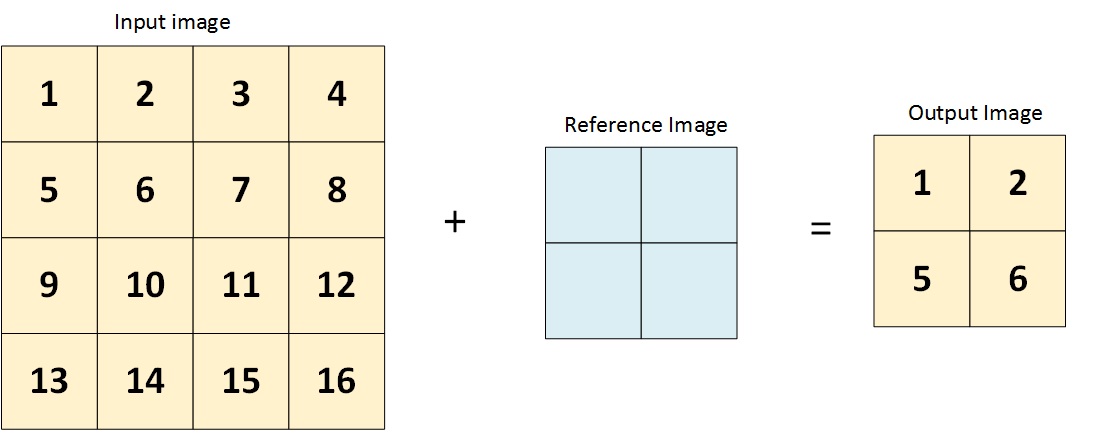
Crop with offset example:

Requirements
- Input, reference and offset layout (order) has to be the same
- Input size cannot be greater than reference size in any dimension
- All sizes have to have positive numbers
- Reference size plus offset cannot exceed input size
Breaking any of this conditions will cause exeption throw.
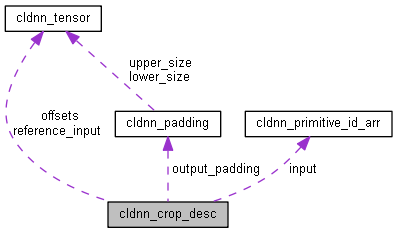
| Class Members | ||
|---|---|---|
| cldnn_primitive_id | id | Primitive id unique within a topology. |
| cldnn_primitive_id_arr | input | Input primitives ids. |
| cldnn_tensor | offsets | Input offsets. |
| cldnn_padding | output_padding | Output padding information. |
| cldnn_tensor | reference_input | Reference input tensor with the required dimensions. |
| cldnn_primitive_type_id | type | Primitive type identificator. |
◆ cldnn_custom_gpu_primitive_desc
| struct cldnn_custom_gpu_primitive_desc |
This primitive executes a custom kernel provided by the application.
The application is required to provide all relevant details for executing the custom kernel such as: sources, entry point, work sizes and parameter bindings.
Definition at line 36 of file custom_gpu_primitive.h.

| Class Members | ||
|---|---|---|
| cldnn_kernel_build_options | build_options | The kernel's build options. |
| cldnn_work_group_sizes | gws | The global working sizes. |
| int | gws_num | The number of global work sizes. |
| cldnn_primitive_id | id | Primitive id unique within a topology. |
| cldnn_primitive_id_arr | input | Input primitives ids. |
| cldnn_kernel_arguments | kernel_arguments | Argument bindings for the entry point function. |
| int | kernel_arguments_num | The number of arguments used by the kernel. |
| cldnn_kernel_entry_point | kernel_entry_point | The name of the entry point function in the kernel. |
| cldnn_primitive_id_arr | kernels_code | Source code for the kernel. |
| cldnn_work_group_sizes | lws | The local working sizes. |
| int | lws_num | The number of local work sizes. |
| cldnn_layout | output_layout | The output layout declared by the primitive. |
| cldnn_padding | output_padding | Output padding information. |
| cldnn_primitive_type_id | type | Primitive type identificator. |
◆ cldnn_data_desc
| struct cldnn_data_desc |
Provides input data to topology.
This primitive allows to pass data which is known at topology creation (constants). For example, weights and biases for scoring networks.
- Note
- Passing data at topology may improve network performance if data optimization is enabled.
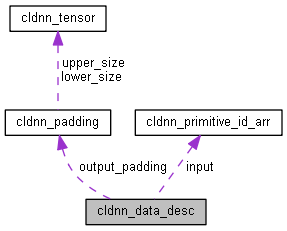
| Class Members | ||
|---|---|---|
| cldnn_primitive_id | id | Primitive id unique within a topology. |
| cldnn_primitive_id_arr | input | Input primitives ids. |
| cldnn_memory | mem |
Memory object which contains data.
|
| cldnn_padding | output_padding | Output padding information. |
| cldnn_primitive_type_id | type | Primitive type identificator. |
◆ cldnn_deconvolution_desc
| struct cldnn_deconvolution_desc |
Performs transposed convolution. Also supports built-in Relu cldnn_activation_desc available by setting it in arguments.
Deconvolution is similar to convolution layer with the weights flipped on the axis and stride and input padding parameters used in opposite sense as in convolution.
Definition at line 36 of file deconvolution.h.

| Class Members | ||
|---|---|---|
| float | activation_negative_slope | Relu activation slope. |
| cldnn_primitive_id_arr | bias |
Array of primitive ids containing bias data. Size of array should be equivalent to split or should be empty (if not using bias). |
| cldnn_primitive_id | id | Primitive id unique within a topology. |
| cldnn_primitive_id_arr | input | Input primitives ids. |
| cldnn_tensor | input_offset | Defines a shift, relative to (0,0) position of the input buffer, where (0,0) point of the deconvolution window should start calculations. |
| cldnn_padding | output_padding | Output padding information. |
| cldnn_tensor | output_size | User-defined output data size of the primitive (w/o padding). |
| uint32_t | split | On how many cards split the computation to. |
| cldnn_tensor | stride | Defines the spatial dimensions of stride of adjacent elements in input buffer. |
| cldnn_primitive_type_id | type | Primitive type identificator. |
| cldnn_primitive_id_arr | weights |
Array of primitive ids containing weights data. Size of array should be equivalent to split. |
| uint32_t | with_activation | Enables Relu activation. |
| uint32_t | with_output_size | Indicates that the primitive has user-defined output size (non-zero value). |
◆ cldnn_detection_output_desc
| struct cldnn_detection_output_desc |
Generates a list of detections based on location and confidence predictions by doing non maximum suppression.
Each row is a 7 dimension vector, which stores: [image_id, label, confidence, xmin, ymin, xmax, ymax]. If number of detections per image is lower than keep_top_k, will write dummy results at the end with image_id=-1.
Definition at line 44 of file detection_output.h.

| Class Members | ||
|---|---|---|
| int | background_label_id | Background label id (-1 if there is no background class). |
| int32_t | code_type | Type of coding method for bounding box. See cldnn_prior_box_code_type. |
| float | confidence_threshold | Only keep detections with confidences larger than this threshold. |
| float | eta | Used for adaptive NMS. |
| cldnn_primitive_id | id | Primitive id unique within a topology. |
| cldnn_primitive_id_arr | input | Input primitives ids. |
| uint32_t | keep_top_k | Number of total bounding boxes to be kept per image after NMS step. |
| float | nms_threshold | Threshold for NMS step. |
| uint32_t | num_classes | Number of classes to be predicted. |
| cldnn_padding | output_padding | Output padding information. |
| uint32_t | share_location | If not 0, bounding box are shared among different classes. |
| int | top_k | Maximum number of results to be kept in NMS. |
| cldnn_primitive_type_id | type | Primitive type identificator. |
| uint32_t | variance_encoded_in_target | If not 0, variance is encoded in target; otherwise we need to adjust the predicted offset accordingly. |
◆ cldnn_eltwise_desc
| struct cldnn_eltwise_desc |
Performs elementwise operations (sum, subtract, max or product) on two input primitives Also supports built-in Relu cldnn_activation_desc available by setting it in arguments. .
- both inputs have to have equal sizes in all dimensions
- format of both inputs has to be the same
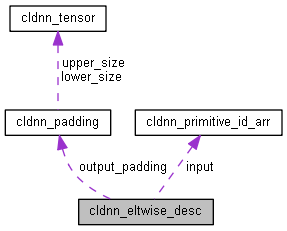
| Class Members | ||
|---|---|---|
| float | activation_negative_slope | Relu activation slope. |
| cldnn_primitive_id | id | Primitive id unique within a topology. |
| cldnn_primitive_id_arr | input | Input primitives ids. |
| int32_t | mode | Eltwise mode. See cldnn_eltwise_mode. |
| cldnn_padding | output_padding | Output padding information. |
| cldnn_primitive_type_id | type | Primitive type identificator. |
| uint32_t | with_activation | Enables Relu activation. |
◆ cldnn_fully_connected_desc
| struct cldnn_fully_connected_desc |
Performs forward fully connected layer (inner product). Also supports built-in Relu cldnn_activation_desc available by setting it in arguments.
Definition at line 35 of file fully_connected.h.
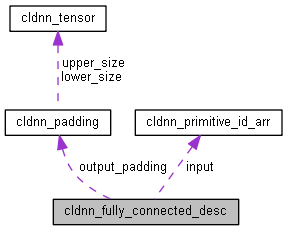
| Class Members | ||
|---|---|---|
| float | activation_negative_slope | Relu activation slope. |
| cldnn_primitive_id | bias | Primitive id containing bias data. |
| cldnn_primitive_id | id | Primitive id unique within a topology. |
| cldnn_primitive_id_arr | input | Input primitives ids. |
| cldnn_padding | output_padding | Output padding information. |
| cldnn_primitive_type_id | type | Primitive type identificator. |
| cldnn_primitive_id | weights | Primitive id containing weights data. |
| uint32_t | with_activation | Enable Relu activation. |
◆ cldnn_input_layout_desc
| struct cldnn_input_layout_desc |
Provides input layout for a data to be passed later to network.
This primitive allows to define the layout for input data which will be passed to network before execution. For example, network input images.
- Note
- User should call network::set_input_data() for every
input_layoutprimitive before network execution.
- See also
- network::set_input_data(), cldnn::data
Definition at line 39 of file input_layout.h.
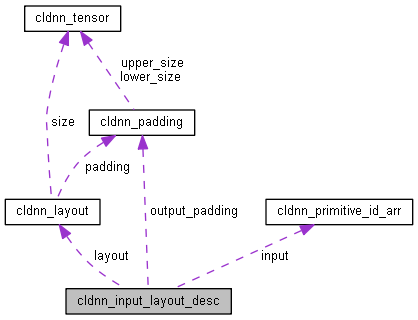
| Class Members | ||
|---|---|---|
| cldnn_primitive_id | id | Primitive id unique within a topology. |
| cldnn_primitive_id_arr | input | Input primitives ids. |
| cldnn_layout | layout | Defines layout for the data will be passed to network. |
| cldnn_padding | output_padding | Output padding information. |
| cldnn_primitive_type_id | type | Primitive type identificator. |
◆ cldnn_lrn_desc
| struct cldnn_lrn_desc |
Local response normalization.
LRN layer as described in chapter 3.3 of "ImageNet Classification with Deep Convolutional
Neural Networks" by Khrizevsky, Sutskever, Hinton.
See: http://www.cs.toronto.edu/~fritz/absps/imagenet.pdf
- Alogrithm:
- b(i,x,y) = a(i,x,y) / (k+alpha*sum(min(N-1, i+n/2); j=max(0,i-n/2); a(j,x,y)^2))
- Where:
- b(i,x,y) : value at x, y from i-th feature map after normalization
- b(i,x,y) : value at x, y from i-th feature map before normalization
- N : number of feature maps
- n : size of normalization
- k, alpha, beta : hyper parameters (equal to 2, 10e-4, 0.75 in paper).
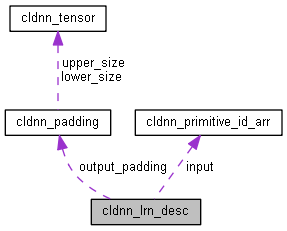
| Class Members | ||
|---|---|---|
| float | alpha | Hyper parameter "alpha". |
| float | beta | Hyper parameter "beta". |
| cldnn_primitive_id | id | Primitive id unique within a topology. |
| cldnn_primitive_id_arr | input | Input primitives ids. |
| float | k | Hyper parameter "k". |
| cldnn_lrn_norm_region | norm_region | Normalize across or within channel. |
| cldnn_padding | output_padding | Output padding information. |
| uint32_t | size | Size of normalization. |
| cldnn_primitive_type_id | type | Primitive type identificator. |
◆ cldnn_normalize_desc
| struct cldnn_normalize_desc |
Normalizes the input using an L2 norm and multiplies the output with scale value. The scale can be equal for all channels or one scale per channel.
The L2 norm is computed as:
Across spatial mode (across_spatial=true)-
norm(i,x,y) = sqrt( Σ( in(f,w,h)^2 ) + epsilon ) where f in range (0,num_of_features), w in range (0,input_width), h in range (0,input_height).
The summation is performed over all the pixels in the batch.
Within spatial mode (across_spatial=false)-
norm(i,x,y) = sqrt( Σ( in(f,x,y)^2 ) + epsilon ) where f in range (0,num_of_features).
The summation is performed over this (x,y) position on all the features.
- Algorithm:
- out(i,x,y) = ( in(i,x,y) / norm(i,x,y) ) * scale(i)
- Where:
- out(i,x,y) : value at x, y from i-th feature map after normalization.
- in(i,x,y) : value at x, y from i-th feature map before normalization.
- norm(i,x,y) : L2 norm as described above.
- scale(i) : the scale value of the i-th feature map.
Definition at line 49 of file normalize.h.
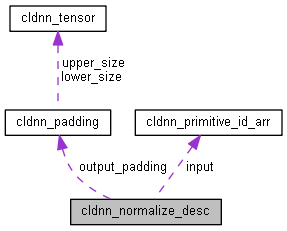
| Class Members | ||
|---|---|---|
| uint32_t | across_spatial | Determines if the normalization is done across or within spatial (see documentation above). |
| float | epsilon | Epsilon for not dividing by zero while normalizing. |
| cldnn_primitive_id | id | Primitive id unique within a topology. |
| cldnn_primitive_id_arr | input | Input primitives ids. |
| cldnn_padding | output_padding | Output padding information. |
| cldnn_primitive_id | scale_input | Scale input primitive id with values needed for scaling after the normalization. Scale x dimension should be 1 (if all channels have the same scale) or equal to input feature size (one scale per channel). All other dimensions should be 1. |
| cldnn_primitive_type_id | type | Primitive type identificator. |
◆ cldnn_permute_desc
| struct cldnn_permute_desc |
Permutes data in the memory, with respect to provided order.
Permute order is set as vector with positions meaning corresponding to tensor. Vector values represent dimensions to be permuted in bfyx format. For example:
input_dimensions = tensor{ 5, 3, 6, 3 }
permute_order = { 2, 3, 1, 0 }
output_dimensions = { 6, 3, 3, 5 }
When permute_order is { 0, 1, 2, 3 } then input_dimensions = output_dimensions
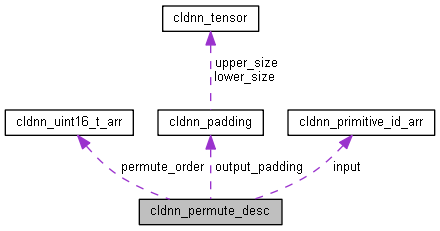
| Class Members | ||
|---|---|---|
| cldnn_primitive_id | id | Primitive id unique within a topology. |
| cldnn_primitive_id_arr | input | Input primitives ids. |
| cldnn_padding | output_padding | Output padding information. |
| cldnn_uint16_t_arr | permute_order | Array of permuted output order in bfyx format. |
| cldnn_primitive_type_id | type | Primitive type identificator. |
◆ cldnn_pooling_desc
| struct cldnn_pooling_desc |
Performs "pooling" operation which is a form of non-linear down-sampling.
Pools the input image by taking the max, average, etc. within regions.
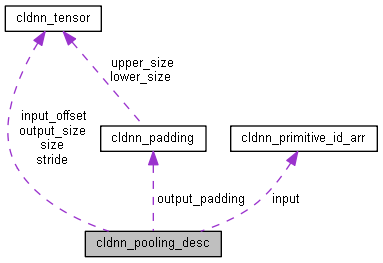
| Class Members | ||
|---|---|---|
| cldnn_primitive_id | id | Primitive id unique within a topology. |
| cldnn_primitive_id_arr | input | Input primitives ids. |
| cldnn_tensor | input_offset | Defines a shift, relative to (0,0) position of the input buffer, where (0,0) point of the pooling window should start calculations. |
| int32_t | mode | Pooling method. See cldnn_pooling_mode. |
| cldnn_padding | output_padding | Output padding information. |
| cldnn_tensor | output_size | User-defined output data size of the primitive (w/o padding). |
| cldnn_tensor | size | Pooling kernel size. |
| cldnn_tensor | stride | Defines shift in input buffer between adjacent calculations of output values. |
| cldnn_primitive_type_id | type | Primitive type identificator. |
| uint32_t | with_output_size | Indicates that the primitive has user-defined output size (non-zero value). |
◆ cldnn_prior_box_desc
| struct cldnn_prior_box_desc |
Generates a set of default bounding boxes with different sizes and aspect ratios.
The prior-boxes are shared across all the images in a batch (since they have the same width and height). First feature stores the mean of each prior coordinate. Second feature stores the variance of each prior coordinate.
Definition at line 37 of file prior_box.h.
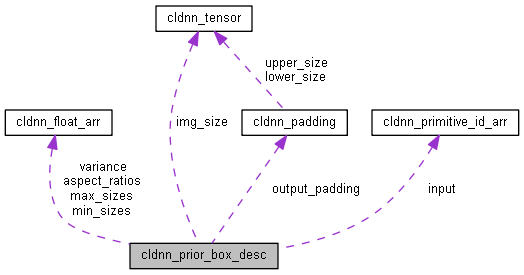
| Class Members | ||
|---|---|---|
| cldnn_float_arr | aspect_ratios | Various of aspect ratios. Duplicate ratios will be ignored. |
| uint32_t | clip | If not 0, will clip the prior so that it is within [0, 1]. |
| uint32_t | flip | If not 0, will flip each aspect ratio. For example, if there is aspect ratio "r", aspect ratio "1.0/r" we will generated as well. |
| cldnn_primitive_id | id | Primitive id unique within a topology. |
| cldnn_tensor | img_size | Image width and height. |
| cldnn_primitive_id_arr | input | Input primitives ids. |
| cldnn_float_arr | max_sizes | Maximum box sizes in pixels. |
| cldnn_float_arr | min_sizes | Minimum box sizes in pixels. |
| float | offset | Offset to the top left corner of each cell. |
| cldnn_padding | output_padding | Output padding information. |
| float | step_height | Step height. |
| float | step_width | Step width. |
| cldnn_primitive_type_id | type | Primitive type identificator. |
| cldnn_float_arr | variance | Variance for adjusting the prior boxes. |
◆ cldnn_proposal_desc
| struct cldnn_proposal_desc |
Definition at line 35 of file proposal.h.
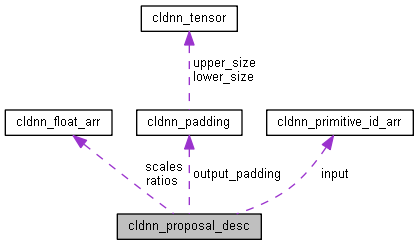
| Class Members | ||
|---|---|---|
| int | feature_stride | |
| cldnn_primitive_id | id | Primitive id unique within a topology. |
| cldnn_primitive_id_arr | input | Input primitives ids. |
| float | iou_threshold | |
| int | max_proposals | |
| int | min_bbox_size | |
| cldnn_padding | output_padding | Output padding information. |
| int | post_nms_topn | |
| int | pre_nms_topn | |
| cldnn_float_arr | ratios | |
| cldnn_float_arr | scales | |
| cldnn_primitive_type_id | type | Primitive type identificator. |
◆ cldnn_region_yolo_desc
| struct cldnn_region_yolo_desc |
region softmax specific for yolo2 topology
- Algorithm:
- Where:
Definition at line 39 of file region_yolo.h.
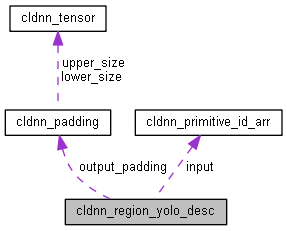
| Class Members | ||
|---|---|---|
| uint32_t | classes | paramter classes |
| uint32_t | coords | paramter coords |
| cldnn_primitive_id | id | Primitive id unique within a topology. |
| cldnn_primitive_id_arr | input | Input primitives ids. |
| uint32_t | num | paramter num |
| cldnn_padding | output_padding | Output padding information. |
| cldnn_primitive_type_id | type | Primitive type identificator. |
◆ cldnn_reorder_desc
| struct cldnn_reorder_desc |
Changes how data is ordered in memory. Value type is not changed & all information is preserved.
Corresponding values are bitwise equal before/after reorder. Also merged with subtraction layer, which can subtract values while doing reordering. NOTE THAT THIS WILL SUBTRACT THE SAME VALUES FROM EACH BATCH.
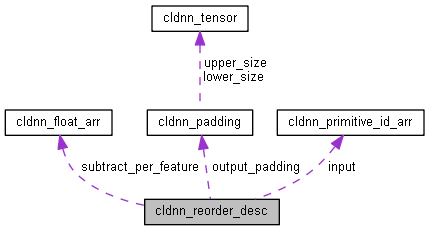
| Class Members | ||
|---|---|---|
| cldnn_primitive_id | id | Primitive id unique within a topology. |
| cldnn_primitive_id_arr | input | Input primitives ids. |
| cldnn_primitive_id | mean_subtract | Primitive id to get mean subtract values. Ignored if subtract_per_featrue is set. |
| cldnn_data_type | output_data_type | Requested memory data type. |
| cldnn_format_type | output_format | Requested memory format. |
| cldnn_padding | output_padding | Output padding information. |
| cldnn_float_arr | subtract_per_feature | Array of mean subtract values. |
| cldnn_primitive_type_id | type | Primitive type identificator. |
◆ cldnn_reorg_yolo_desc
| struct cldnn_reorg_yolo_desc |
yolo2 topology specific data reorganization primitive
- Algorithm:
- Where:
Definition at line 39 of file reorg_yolo.h.
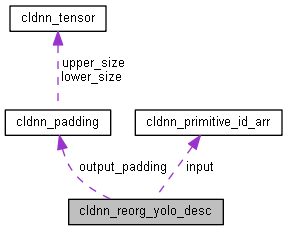
| Class Members | ||
|---|---|---|
| cldnn_primitive_id | id | Primitive id unique within a topology. |
| cldnn_primitive_id_arr | input | Input primitives ids. |
| cldnn_padding | output_padding | Output padding information. |
| uint32_t | stride | paramter stride |
| cldnn_primitive_type_id | type | Primitive type identificator. |
◆ cldnn_reshape_desc
| struct cldnn_reshape_desc |
Changes information about inputs's layout effectively creating new memory which share underlaying buffer but is interpreted in a different way (different shape).
- Note
- reshape primitive is supposed only to reinterpret shape of the memory therefore it's not possible to change neither data type nor format of the input buffer and total number of elements in input and output (excluding paddings) must match.
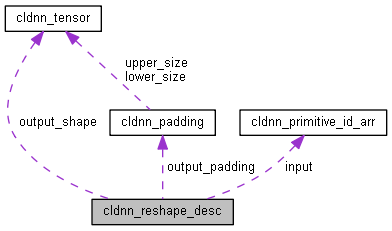
| Class Members | ||
|---|---|---|
| cldnn_primitive_id | id | Primitive id unique within a topology. |
| cldnn_primitive_id_arr | input | Input primitives ids. |
| cldnn_padding | output_padding | Output padding information. |
| cldnn_tensor | output_shape | Requested memory shape. |
| cldnn_primitive_type_id | type | Primitive type identificator. |
◆ cldnn_roi_pooling_desc
| struct cldnn_roi_pooling_desc |
Definition at line 34 of file roi_pooling.h.
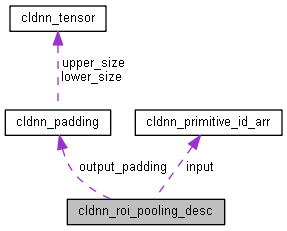
| Class Members | ||
|---|---|---|
| int | group_sz | Group size as defined by PSRoIPooling when > 0, else if 0 means regular RoIPooling. |
| cldnn_primitive_id | id | Primitive id unique within a topology. |
| cldnn_primitive_id_arr | input | Input primitives ids. |
| int32_t | mode | Pooling method. See cldnn_pooling_mode. |
| cldnn_padding | output_padding | Output padding information. |
| int | pooled_height | Output height. |
| int | pooled_width | Output width. |
| float | spatial_scale | Ratio of the coordinates used in RoIs to the width (and height) of the input data. |
| cldnn_primitive_type_id | type | Primitive type identificator. |
◆ cldnn_scale_desc
| struct cldnn_scale_desc |
Performs elementwise product of input and scale_input.
Scale input dimension should be equal to input dimension or be 1 if it is not there.
Input size : 2x3x4x5(BFYX)
Possible scale inputs sizes :
2x3x4x5 - works the same as(axis == 0 == -4) in caffe
1x3x4x5 - works the same as(axis == 1 == -3) in caffe
1x1x4x5 - works the same as(axis == 2 == -2) in caffe
1x1x1x5 - works the same as(axis == 3 == -1) in caffe
1x1x1x1 - works the same as empty shape(scalar) in caffe
When scale_input is the same as input, the behavior is the same as cldnn_eltwise_desc with product operation.
Performs scale over feature when the scale feature size is equal to input feature size.
Performs scale over feature in batch when the scale feature and scale batch sizes are equal to input feature and input batch sizes.
Optionally it can also add provided biases by setting bias_term.
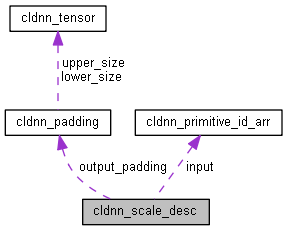
| Class Members | ||
|---|---|---|
| cldnn_primitive_id | bias | Primitive id containing bias data. |
| cldnn_primitive_id | id | Primitive id unique within a topology. |
| cldnn_primitive_id_arr | input | Input primitives ids. |
| cldnn_padding | output_padding | Output padding information. |
| cldnn_primitive_type_id | type | Primitive type identificator. |
◆ cldnn_softmax_desc
| struct cldnn_softmax_desc |
Normalizes results so they sum to 1. The scope of normalization is defined by a member dimension.
- Algorithm:
- b = e^a/sum(N-1; j=0; e^j)
- Where:
- N : number of values to normalize
- b : value after normalization
- a : value before normalization
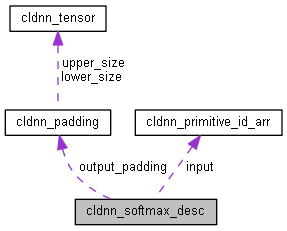
| Class Members | ||
|---|---|---|
| cldnn_softmax_dimension | dimension |
Defines a scope of a single softmax normalization. Being given a 4-dimensional input, which consists of b,f,y,x dimensions, softmax normalizes data which are divided into multiple independent sets. Specific behavior is determined by this parameter, as follows:
|
| cldnn_primitive_id | id | Primitive id unique within a topology. |
| cldnn_primitive_id_arr | input | Input primitives ids. |
| cldnn_padding | output_padding | Output padding information. |
| cldnn_primitive_type_id | type | Primitive type identificator. |
◆ cldnn_split_desc
| struct cldnn_split_desc |
Performs split operation on input.
splits the input data into n parts, for each user provides name and offsets.
User cannot use split primitive directly.
It is needed to refer to the output ids with the name "<split_prim_id>:<split_output_id>".
Assumptions
- offsets1 < offsets2 < offsets3 < ...
- size[n] = offsets[n+1] - offsets[n];
- last element: size[n] = split_input.size - offsets[n];
- no buffer overlapping, as the output size is calculated using offset and input size
- split primitive id cannot be used by any other primitive (user needs to use output_ids only)
Breaking any of this conditions will cause exeption throw.
Example:
Splitting output to 2 parts by the features:
input_size = { 2, 4, 3, 5 };
split_id = "split";
output_ids_offsets[0] = { "out0", { 0,0,0,0 } };
output_ids_offsets[1] = { "out1", { 0,2,0,0 } };
After split there would be 2 primitives: "split:out0" and "split:out1" which contain 2 feature maps (lower and upper)
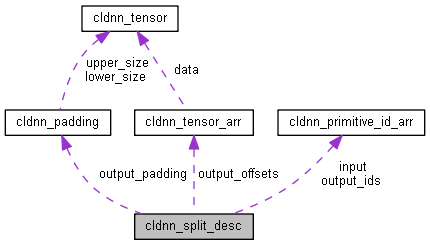
| Class Members | ||
|---|---|---|
| cldnn_primitive_id | id | Primitive id unique within a topology. |
| cldnn_primitive_id_arr | input | Input primitives ids. |
| cldnn_primitive_id_arr | output_ids | List of output_ids. |
| cldnn_tensor_arr | output_offsets | Array of tensors with offsets. |
| cldnn_padding | output_padding | Output padding information. |
| cldnn_primitive_type_id | type | Primitive type identificator. |
◆ cldnn_upsampling_desc
| struct cldnn_upsampling_desc |
Performs nearest neighbor/bilinear upsampling Also supports built-in Relu activation available by setting it in arguments.
Definition at line 44 of file upsampling.h.
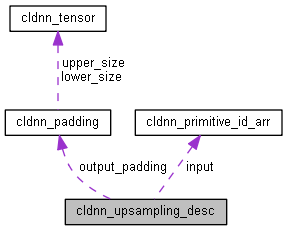
| Class Members | ||||
|---|---|---|---|---|
| float | activation_negative_slope | Relu activation slope. | ||
| cldnn_primitive_id | id | Primitive id unique within a topology. | ||
| cldnn_primitive_id_arr | input | Input primitives ids. | ||
| uint32_t | num_filter |
| ||
| cldnn_padding | output_padding | Output padding information. | ||
| int32_t | sample_type |
| ||
| uint32_t | scale |
| ||
| cldnn_primitive_type_id | type | Primitive type identificator. | ||
| uint32_t | with_activation | Enables Relu activation. | ||
Enumeration Type Documentation
◆ cldnn_eltwise_mode
| enum cldnn_eltwise_mode |
Select mode for eltwise layer ( cldnn_eltwise_desc ).
| Enumerator | |
|---|---|
| cldnn_eltwise_sum | Eltwise sum. |
| cldnn_eltwise_sub | Eltwise subtract. |
| cldnn_eltwise_max | Eltwise max. |
| cldnn_eltwise_prod | Eltwise product (Hamarad). |
◆ cldnn_pooling_mode
| enum cldnn_pooling_mode |
Select method for Pooling layer ( cldnn_pooling_desc ).
◆ cldnn_upsampling_sample_type
Sample mode for upsampling layer ( cldnn_upsampling_desc ).
| Enumerator | |
|---|---|
| cldnn_upsampling_nearest | upsampling nearest neighbor. |
| cldnn_upsampling_bilinear | upsampling bilinear. |
Definition at line 34 of file upsampling.h.
